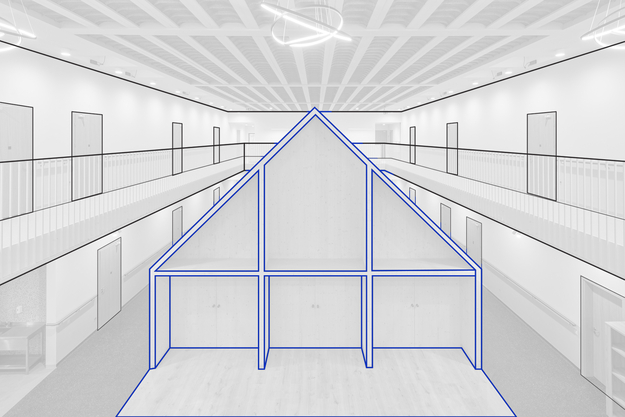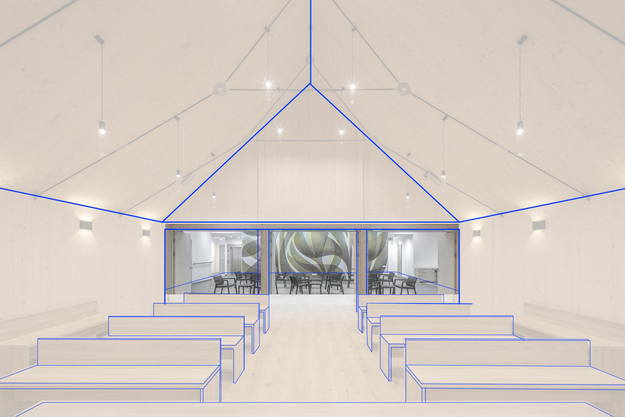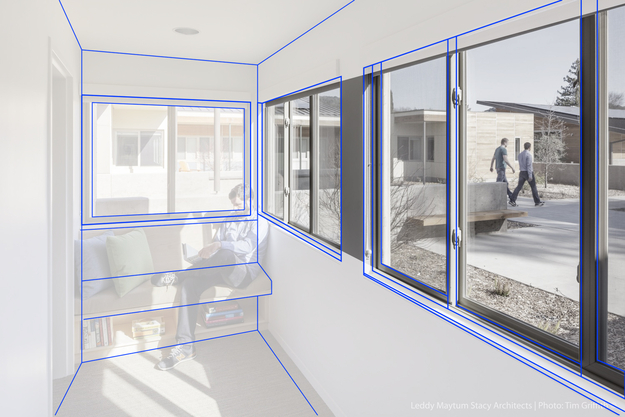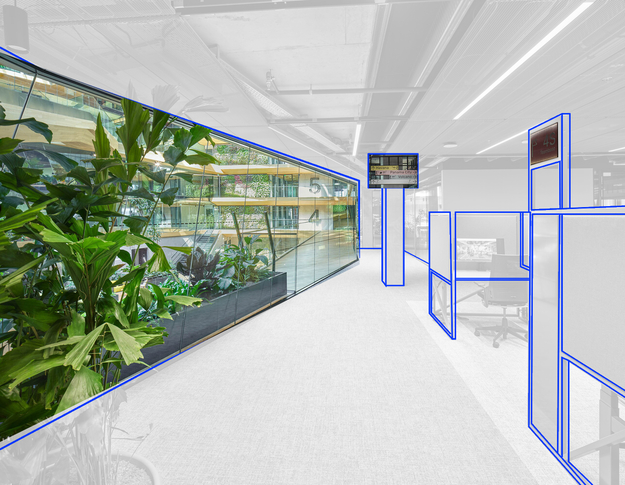The design of the built environments has traditionally centered around the needs of neurotypical people. Autistic individuals often develop coping mechanisms to navigate and cope with the challenges presented by neurotypical-oriented built environments. These strategies allow autistic individuals to navigate and function within neurotypical-oriented built environments, albeit with varying degrees of success and challenges. This adaptive approach can be named as an "autistic escape" which is a concept coined by Magda Mostafa. Here we discuss what we can learn from autistic escape as an architect to design more inclusive space.
Autistic escape isn't about running away or avoiding reality. Instead, it’s a unique way of experiencing and interacting with the world. Imagine it as stepping beyond the ordinary boundaries—a transcendence that allows autistic individuals to navigate life in their own distinctive manner. Autistic individuals perceive and respond to sensory stimuli—such as sunlight, the feel of different materials, and the absence of noise—in ways that may seem extraordinary to others. Autistic minds map out constellations of sensory input. Each touch, sound, or visual detail becomes a point in their personal cosmos. Like celestial cartographers, they chart their own paths through this sensory universe, creating patterns and connections that are uniquely their own. The very buildings we construct become both sanctuary and tempest for autistic individuals. Within these walls, they seek refuge—a place where sensory overload can be tempered, where they can find solace. In essence, autistic escape is a symphony of perception, a way of being that invites us to see the world through a different lens—one that celebrates the intricate interplay of light, texture, and silence within the structures we inhabit.
1.Sensory Sensitivity
Autistic individuals often develop innovative coping mechanisms to navigate the overwhelming sensory landscape of built environments, including creating personal retreat spaces within larger areas and relying on sensory modulation techniques such as noise-cancelling headphones and tactile tools to filter out unwanted stimuli. Architects can draw inspiration from these strategies by integrating designated quiet zones, adjustable lighting systems, and clear wayfinding systems into their designs, providing individuals with the ability to customize their sensory experience and navigate complex environments more effectively. By incorporating these elements, architects can create more inclusive and supportive spaces that accommodate diverse sensory needs while promoting the well-being of all occupants
2. Spatial Perception
2.1Attention to Detail
Autistic individuals often possess a keen eye for detail and a preference for order and symmetry. This unique way of perceiving space can influence architectural aesthetics, encouraging designers to explore geometric patterns, modular structures, and minimalist design principles. By embracing the preferences of autistic individuals for simplicity and clarity, architects can create environments that are visually harmonious and mentally stimulating without being overwhelming.
2.2Personalizes Space
Autistic individuals often cope with sensory overload by seeking flexibility and personalization in their environments. They thrive in spaces that offer adaptability, where they can customise their surroundings to suit their sensory needs. Architects can support this coping mechanism by incorporating features like modular furniture arrangements and customizable lighting schemes, empowering occupants to create environments that promote comfort and well-being.
2.3Predictibility and Routine
Autistic individuals prefer routine and predictability, shaping their interaction with built environments. Architects can incorporate predictability into designs, offering stability for all. Clear pathways, consistent layouts, and visual cues support routine-based activities. Collaboration with autistic individuals ensures designs meet their needs, fostering belonging and empowerment. This approach promotes well-being and quality of life.
Let's have a look at some of the examples:
Home for The Homeless / xystudio
The inner courtyard of the building, which has a living room and a chapel, is surrounded by all the other rooms on two floors. Chapel gives a sense of peace. It’s still part of public space but it also provides isolation and calmness in the environment. The inner courtyard, featuring a latticed railing on the upper level, offers a feeling of both openness and authority. Here, we can peacefully oversee the activities on the lower level, engage in conversation with those beneath us, or maintain our distance if necessary.
Home for The Homeless / xystudio - Photo by Piotr Krajewski
Collage by Irem Biter
Home for Homeless / xystudio - Photo by Piotr Krajewski
Collage by Irem Biter
Sweetwater Spectrum Community / LMS Architects
Sweetwater spectrum community by LMS Architects represents a fresh approach to supportive housing nationwide, specifically designed to cater to the needs of adults with autism. It provides an environment where residents can lead fulfilling lives with a sense of purpose and dignity. Architects follow design strategies which is legibility, preview and retreat, predictability and calm spaces
Legibility: A clear and consistent layout ensures distinct boundaries between public, semi-public, semi-private, and private areas.
Preview and relaxation: Residents can preview various spaces and activities, and they have access to retreat areas for tranquility.
Predictability : The design of all four homes is alike, fostering a sense of ease for residents when visiting or moving between houses on the property.
Calm spaces: All spaces are crafted to minimize sensory input and create a peaceful atmosphere. Shapes are recognizable, colors and finishes are muted, and lighting is predominantly indirect.
Sweetwater Spectrum Community / LMS Architects - Photo by Tim Griffith
Collage by Irem Biter

Booking.com City Campus / UNStudio, HofmanDujardin, CBRE, MOSS, Mijksenaar
HofmanDujardin and CBRE teamed up to create a customized workplace design for a company, offering different types of workspaces on each floor to suit various levels of focus. They used colorful acoustic screens to define workstations and provided closed booths for calls or small meetings. Additionally, there are 28 themed breakout areas near work floors, equipped with amenities like meeting rooms and lounges, to encourage collaboration while maintaining a quiet work environment.
The overall design of the urban campus emphasizes diversity and continuity through layered architecture supervised by specialist designers. Greenery is a key feature, with a green masterplan by MOSS incorporating elements like botanical staircases, green walls, and rooftop gardens to boost employee mood and productivity. The integration of nature extends to breakout spaces, creating diverse environments resembling travel destinations with various plant species and vertical farming for fresh dining experiences.
Mijksenaar handled wayfinding and graphics, ensuring clear navigation throughout the campus while reflecting the company's identity. Their design uses consistent colors, grid elements, and playful typography to guide visitors seamlessly from bicycle parking to breakout spaces, fostering a sense of connection and empowerment to explore the Booking.com campus.
Booking.com City Campus - Photo by Matthijs van Roon
Collage by Irem Biter
In essence, understanding the coping mechanisms that autistic individuals utilise to regulate sensory overload in the built environment offers architects valuable insights into designing more inclusive and supportive spaces. By incorporating elements such as retreat spaces, sensory modulation tools, and visual organisation strategies into architectural designs, architects can create environments that accommodate diverse sensory needs and promote the well-being of all occupants. Through thoughtful consideration of these coping mechanisms, architects can contribute to the creation of more accessible and inclusive built environments for autistic individuals and neurotypical individuals alike.
References
Amaze. (2018). Accessible environments for autistic people
National Autistic Society. (2022). Accessible environments
Mostafa, M. (2021). The Autism Friendly University Design Guide. Autism Friendly DCU, Dublin, Ireland.
Archdaily. (2013). An Interview with Magda Mostafa: Pioneer in Autism Design
Archdaily. (2024). Home for The Homeless / xystudio
Archdaily. (2013). Sweetwater Spectrum Community / LMS Architects
Designboom. (2023). booking.com's nature-filled city campus by UNStudio & hofmandujardin opens in amsterdam